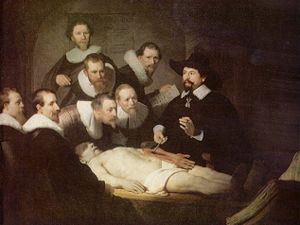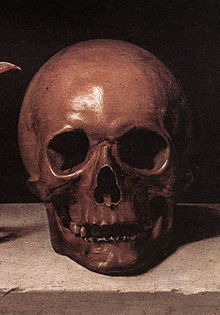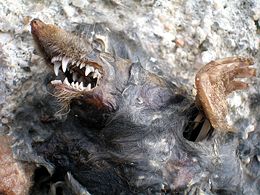Death
2008/9 Schools Wikipedia Selection. Related subjects: Health and medicine

Death is the termination of the biological functions that define living organisms. It refers both to a specific event and, particularly in humans, to a condition, the true nature of which it has for millennia been a central concern of the world's religious traditions and philosophers to penetrate.
Numerous factors can cause death: predation, disease, habitat destruction, senescence, suicide, conflict, malnutrition, for example, or mere accidents resulting in terminal physical injury. Principal cause of death in people in developed countries is disease precipitated by aging. The chief concern of medical science has been to postpone and avert death. Precise medical definition of death, however, becomes more problematic, paradoxically, as scientific knowledge and technology advance.
Biological death
Fate of dead organisms
In animals, small movements of the limbs (for example twitching legs or wings) known as a postmortem spasm can sometimes be observed for some time following death. Pallor mortis is a postmortem paleness which accompanies death due to a lack of capillary circulation throughout the body. Algor mortis describes the predictable decline in body temperature until ambient temperature is reached. Within a few hours of death rigor mortis is observed with a chemical change in the muscles, causing the limbs of the corpse to become stiff (Latin rigor) and difficult to move or manipulate. Assuming mild temperatures, full rigor occurs at about 12 hours, eventually subsiding to relaxation at about 36 hours; however, decomposition is not always a slow process. Fire, for example, is the primary mode of decomposition in most grassland ecosystems.
Some organisms have hard parts such as shells or bones which may fossilize before decomposition can occur. Fossils are the mineralized or otherwise preserved remains or traces (such as footprints) of animals, plants, and other organisms. Fossils vary in size from microscopic, such as single cells, to gigantic, such as dinosaurs. A fossil normally preserves only a small portion of the deceased organism, usually that portion that was partially mineralized during life, such as the bones and teeth of vertebrates, or the chitinous exoskeletons of invertebrates. Preservation of soft tissues, such as in mummification, is extremely rare in the fossil record.
Competition, natural selection and extinction
Death is an important part of the process of natural selection. Organisms that are less adapted to their current environment than others are more likely to die having produced fewer offspring, reducing their contribution to the gene pool of succeeding generations. Weaker genes are thus eventually bred out of a population, leading to processes such as speciation and extinction. It should be noted however that reproduction plays an equally important role in determining survival, for example an organism that dies young but leaves many offspring will have a much greater Darwinian fitness than a long-lived organism which leaves only one.
Extinction

Extinction is the cessation of existence of a species or group of taxa, reducing biodiversity. The moment of extinction is generally considered to be the death of the last individual of that species (although the capacity to breed and recover may have been lost before this point). Because a species' potential range may be very large, determining this moment is difficult, and is usually done retrospectively. This difficulty leads to phenomena such as Lazarus taxa, where a species presumed extinct abruptly "reappears" (typically in the fossil record) after a period of apparent absence.
Through evolutional theory, new species arise through the process of speciation — where new varieties of organisms arise and thrive when they are able to find and exploit an ecological niche — and species become extinct when they are no longer able to survive in changing conditions or against superior competition. A typical species becomes extinct within 10 million years of its first appearance, although some species, called living fossils, survive virtually unchanged for hundreds of millions of years. Only one in a thousand species that have existed remain today.
After death the remains of an organism become part of the biogeochemical cycle. Animals may be consumed by a predator or a scavenger. Organic material may then be further decomposed by detritivores, organisms which recycle detritus, returning it to the environment for reuse in the food chain. Examples of detritvores include earthworms, woodlice and dung beetles.
Microorganisms also play a key role, raising the temperature of the decomposing matter as they break it down into yet simpler molecules. Not all material need be decomposed fully, however. Coal, a fossil fuel formed over vast tracts of time in swamp ecosystems, is one example.
Death and evolution
Enquiry into the evolution of aging aims to explain why almost all living things weaken and die with age (a notable exception being hydra, which may be biologically immortal). The evolutionary origin of senescence remains one of the fundamental puzzles of biology. Gerontology specializes in the science of human aging processes.
Death in medicine
Problems of definition
Historically, attempts to define the exact moment of death have been problematic. Death was once defined as the cessation of heartbeat ( cardiac arrest) and of breathing, but the development of CPR and prompt defibrillation have rendered that definition inadequate because breathing and heartbeat can sometimes be restarted. This is now called " clinical death". Events which were causally linked to death in the past no longer kill in all circumstances; without a functioning heart or lungs, life can sometimes be sustained with a combination of life support devices, organ transplants and artificial pacemakers.
Today, where a definition of the moment of death is required, doctors and coroners usually turn to " brain death" or "biological death": People are considered dead when the electrical activity in their brain ceases (cf. persistent vegetative state). It is presumed that a stoppage of electrical activity indicates the end of consciousness. However, suspension of consciousness must be permanent, and not transient, as occurs during certain sleep stages, and especially a coma. In the case of sleep, EEGs can easily tell the difference. Identifying the moment of death is important in cases of transplantation, as an organ for transplant must be harvested as quickly as possible after the death of the body.
The possession of brain activities, or ability to resume brain activity, is a necessary condition to legal personhood in the United States. "It appears that once brain death has been determined … no criminal or civil liability will result from disconnecting the life-support devices." (Dority v. Superior Court of San Bernardino County, 193 Cal.Rptr. 288, 291 (1983))
Those people maintaining that only the neo-cortex of the brain is necessary for consciousness sometimes argue that only electrical activity there should be considered when defining death. Eventually it is possible that the criterion for death will be the permanent and irreversible loss of cognitive function, as evidenced by the death of the cerebral cortex. All hope of recovering human thought and personality is then gone given current and foreseeable medical technology. However, at present, in most places the more conservative definition of death — irreversible cessation of electrical activity in the whole brain, as opposed to just in the neo-cortex — has been adopted (for example the Uniform Determination Of Death Act in the United States). In 2005, the case of Terri Schiavo brought the question of brain death and artificial sustenance to the front of American politics.
Even by whole-brain criteria, the determination of brain death can be complicated. EEGs can detect spurious electrical impulses, while certain drugs, hypoglycemia, hypoxia, or hypothermia can suppress or even stop brain activity on a temporary basis. Because of this, hospitals have protocols for determining brain death involving EEGs at widely separated intervals under defined conditions.
Misdiagnosed death
There are many anecdotal references to people being declared dead by physicians and then 'coming back to life', sometimes days later in their own coffin, or when embalming procedures are just about to begin. Owing to significant scientific advancements in the Victorian era, some people in Britain became obsessively worried about living after being declared dead.
A first responder is not authorized to pronounce a patient dead. Some EMT training manuals specifically state that a person is not to be assumed dead unless there are clear and obvious indications that death has occurred. These indications include mortal decapitation, rigor mortis (rigidity of the body), livor mortis (blood pooling in the part of the body at lowest elevation), decomposition, incineration, or other bodily damage that is clearly inconsistent with life. If there is any possibility of life and in the absence of a do not resuscitate (DNR) order, emergency workers are instructed to begin resuscitation and not end it until a patient has been brought to a hospital to be examined by a physician. This frequently leads to situation of a patient being pronounced dead on arrival (DOA). However, some states allow paramedics to pronounce death. This is usually based on specific criteria. Aside from the above mentioned, conditions include advanced measures including CPR, intubation, IV access, and administering medicines without regaining a pulse for at least 20 minutes.
In cases of electric shock, CPR for an hour or longer can allow stunned nerves to recover, allowing an apparently dead person to survive. People found unconscious under icy water may survive if their faces are kept continuously cold until they arrive at an emergency room. This "diving response", in which metabolic activity and oxygen requirements are minimal, is something humans share with cetaceans called the mammalian diving reflex.
As medical technologies advance, ideas about when death occurs may have to be re-evaluated in light of the ability to restore a person to vitality after longer periods of apparent death (as happened when CPR and defibrillation showed that cessation of heartbeat is inadequate as a decisive indicator of death). The lack of electrical brain activity may not be enough to consider someone scientifically dead. Therefore, the concept of information theoretical death has been suggested as a better means of defining when true death actually occurs, though the concept has few practical applications outside of the field of cryonics.
There have been some scientific attempts to bring dead organisms back to life, but with limited success. In science fiction scenarios where such technology is readily available, real death is distinguished from reversible death.
Death and the law
By law, a person is dead if a Statement of Death or Death Certificate is approved by a licensed medical practitioner. Various legal consequences follow death, including the removal from the person of what in legal terminology is called personhood.
Causes of human death
Death can be caused by disease, suffocation/ asphyxiation or prolonged lack of oxygen to the brain, or physical trauma as a result of an accident ("unintentional circumstance"), homicide ("intentional act by someone else"), or suicide ("intentional act against one's self"). The leading cause of death in developing countries is infectious disease. The leading causes of death in developed countries are atherosclerosis ( heart disease and stroke), cancer, and other diseases related to obesity and aging. These conditions cause loss of homeostasis, leading to cardiac arrest, causing loss of oxygen and nutrient supply, causing irreversible deterioration of the brain and other tissues. With improved medical capability, dying has become a condition to be managed. Home deaths, once normal, are now rare in the developed world.
In developing nations, inferior sanitary conditions and lack of access to modern medical technology makes death from infectious diseases more common than in developed countries. One such disease is tuberculosis, a bacterial disease which killed 1.7 million people in 2004. Malaria causes about 400–900 million cases of fever and approximately one to three million deaths annually. AIDS death toll in Africa may reach 90-100 million by 2025.
According to Jean Ziegler, who was the United Nations Special reporter on the Right to Food from 2000 to March 2008; mortality due to malnutrition accounted for 58% of the total mortality rate in 2006. Ziegler says worldwide approximately 62 millions people died from all causes and of those deaths more than 36 millions died of hunger or diseases due to deficiencies in micronutrients."
Tobacco smoking killed 100 million people worldwide in the 20th century and could kill 1 billion people around the world in the 21st century, the WHO Report warned.
Many leading developed world causes of death can be postponed by diet and physical activity, but the accelerating incidence of disease with age still imposes limits on human longevity. The evolutionary cause of aging is, at best, only just beginning to be understood. It has been suggested that direct intervention in the aging process may now be the most effective intervention against major causes of death.
Symptoms of death
Signs of death, strong indications, at the very least, that a person is no longer alive are:
- Pallor mortis, paleness which happens almost instantaneously (in the 15–120 minutes after the death)
- Algor mortis, the reduction in body temperature following death. This is generally a steady decline until matching ambient temperature
- Rigor mortis, the limbs of the corpse become stiff (Latin rigor) and difficult to move or manipulate
- Livor mortis, a settling of the blood in the lower (dependent) portion of the body
- Decomposition, the reduction into simpler forms of matter.
The autopsy

An autopsy, also known as a postmortem examination or an obduction, is a medical procedure that consists of a thorough examination of a human corpse to determine the cause and manner of a person's death and to evaluate any disease or injury that may be present. It is usually performed by a specialized medical doctor called a pathologist.
Autopsies are either performed for legal or medical purposes. A forensic autopsy is carried out when the cause of death may be a criminal matter, while a clinical or academic autopsy is performed to find the medical cause of death and is used in cases of unknown or uncertain death, or for research purposes. Autopsies can be further classified into cases where external examination suffices, and those where the body is dissected and an internal examination is conducted. Permission from next of kin may be required for internal autopsy in some cases. Once an internal autopsy is complete the body is reconstituted by sewing it back together. Autopsy is important in a medical environment and may shed light on mistakes and help improve practices.
A necropsy is an older term for a postmortem examination, unregulated, and not always a medical procedure.
The quest for life extension
Life extension refers to an increase in maximum or average lifespan, especially in humans, by slowing down or reversing the processes of aging. Average lifespan is determined by vulnerability to accidents and age or lifestyle-related afflictions such as cancer or cardiovascular disease. Extension of average lifespan can be achieved by good diet, exercise and avoidance of hazards such as smoking. Maximum lifespan is determined by the rate of aging for a species inherent in its genes. Currently, the only widely recognized method of extending maximum lifespan is calorie restriction. Theoretically, extension of maximum lifespan can be achieved by reducing the rate of aging damage, by periodic replacement of damaged tissues, or by molecular repair or rejuvenation of deteriorated cells and tissues.
Researchers of life extension are a subclass of biogerontologists known as "biomedical gerontologists". They try to understand the nature of aging and they develop treatments to reverse aging processes or to at least slow them down, for the improvement of health and the maintenance of youthful vigor at every stage of life. Those who take advantage of life extension findings and seek to apply them upon themselves are called "life extensionists" or "longevists". The primary life extension strategy currently is to apply available anti-aging methods in the hope of living long enough to benefit from a complete cure to aging once it is developed, which given the rapidly advancing state of biogenetic and general medical technology, could conceivably occur within the lifetimes of people living today.
Many biomedical gerontologists and life extensionists believe that future breakthroughs in tissue rejuvenation with stem cells, organs replacement (with artificial organs or xenotransplantations) and molecular repair will eliminate all aging and disease as well as allow for complete rejuvenation to a youthful condition. Whether such breakthroughs can occur within the next few decades is impossible to predict. Some life extensionists arrange to be cryonically preserved upon legal death so that they can await the time when future medicine can eliminate disease, rejuvenate them to a lasting youthful condition and repair damage caused by the cryonics process.
Death in culture
Death is the centre of many traditions and organizations, and is a feature of every culture around the world. Much of this revolves around the care of the dead, as well as the afterlife and the disposal of bodies upon the onset of death. The disposal of human corpses does, in general, begin with the last offices before significant time has passed, and ritualistic ceremonies often occur, most commonly interment or cremation. This is not a unified practice, however, as in Tibet for instance the body is given a sky burial and left on a mountain top. Mummification or embalming is also prevalent in some cultures, to retard the rate of decay.
Such rituals are accompanied by grief and mourning in almost all cases, and this is not limited to human loss, but extends to the loss of an animal. Legal aspects of death are also part of many cultures, particularly the settlement of the deceased estate and the issues of inheritance and in some countries, inheritance taxation.
Capital punishment is also a divisive aspect of death in culture. In most places that practice capital punishment today, the death penalty is reserved as punishment for premeditated murder, espionage, treason, or as part of military justice. In some countries, sexual crimes, such as adultery and sodomy, carry the death penalty, as do religious crimes such as apostasy, the formal renunciation of one's religion. In many retentionist countries, drug trafficking is also a capital offense. In China human trafficking and serious cases of corruption are also punished by the death penalty. In militaries around the world courts-martial have imposed death sentences for offenses such as cowardice, desertion, insubordination, and mutiny.
Death in warfare and in suicide attack also have cultural links, and the ideas of dulce et decorum est pro patria mori, mutiny punishable by death, grieving relatives of dead soldiers and death notification are embedded in many cultures. Recently in the western world, with the increase in terrorism following the September 11 attacks, but also further back in time with suicide bombers and terrorism in Northern Ireland, kamikaze missions in World War II and suicide missions in a host of other conflicts in history, death for a cause by way of suicide attack, and martyrdom have had significant cultural impacts.
Suicide in general, and particularly euthanasia are also points of cultural debate. Both acts are understood very differently in contrasting cultures. In Japan, for example, ending a life with honour by hara kiri is considered a desirable death, whereas in many western cultures the idea of euthanasia is looked upon with mixed feelings. Death is also personified in many cultures, with such creations as the Grim Reaper, Azrael, Father Time. Such cultural ideas are part of a global fascination with death.
Abortion is the deliberate termination of a human pregnancy. This is partially legalised in many Western countries if the mother requests it, and a doctor prescribes it, often taking into account the physical and mental state of the mother-to-be, and the age of the foetus. In countries where abortion is legal, it is understood that the rights of the mother outweigh the rights of the unborn child. Some ethicists and religious groups argue that this is wrong and that the child has a right to life. In countries where abortion is illegal, many "back-alley" ( unsafe abortions) may still occur with great risk to the health of the mother.



